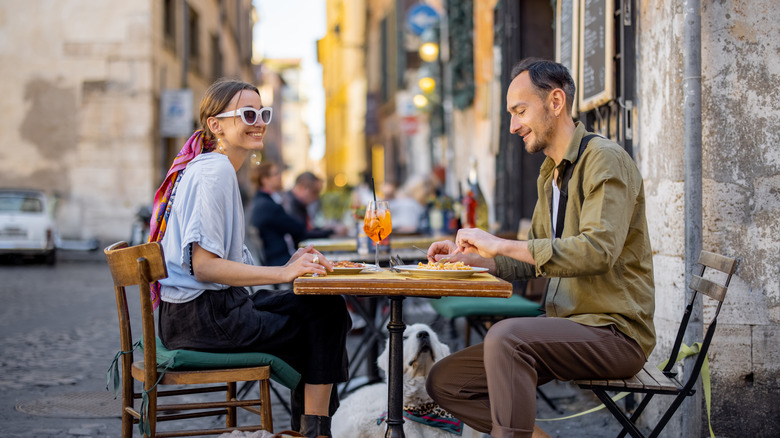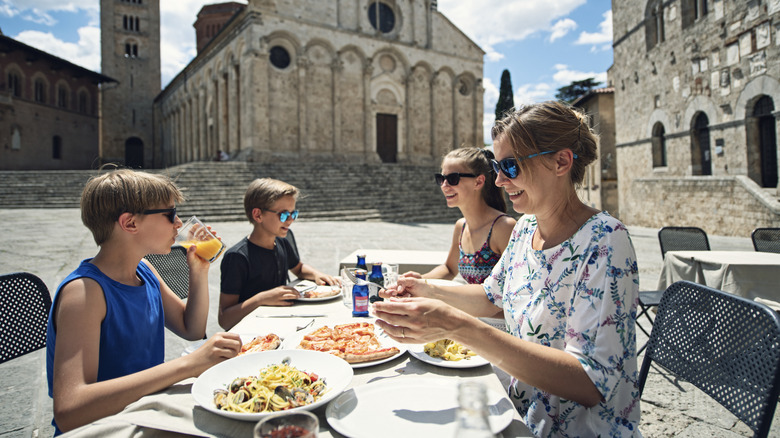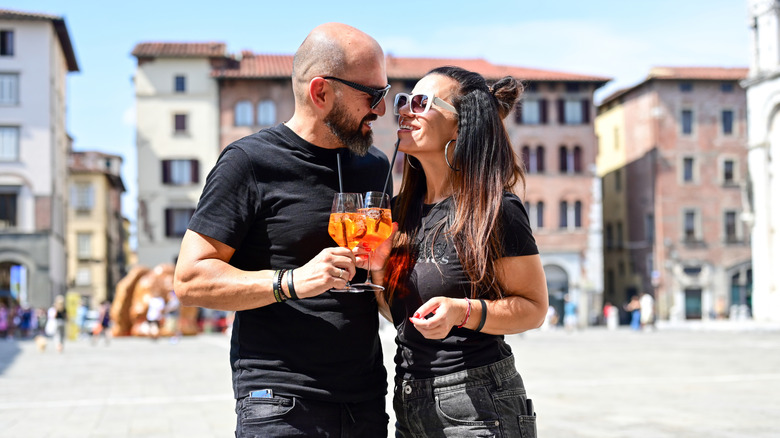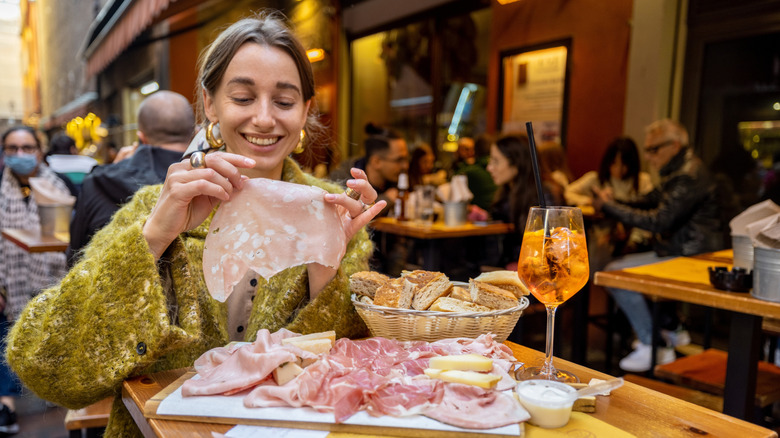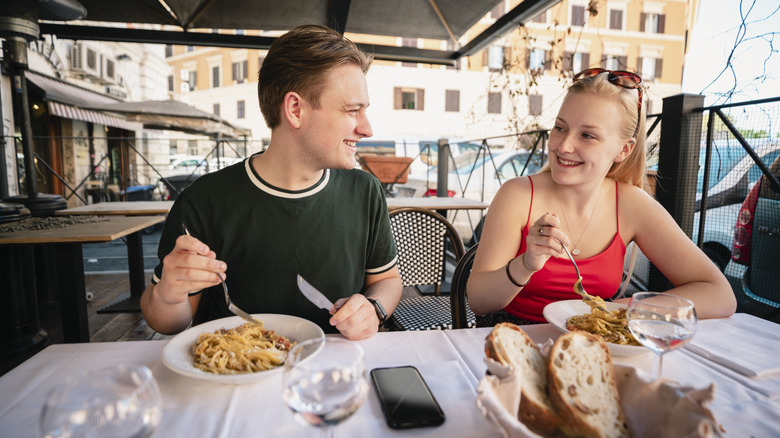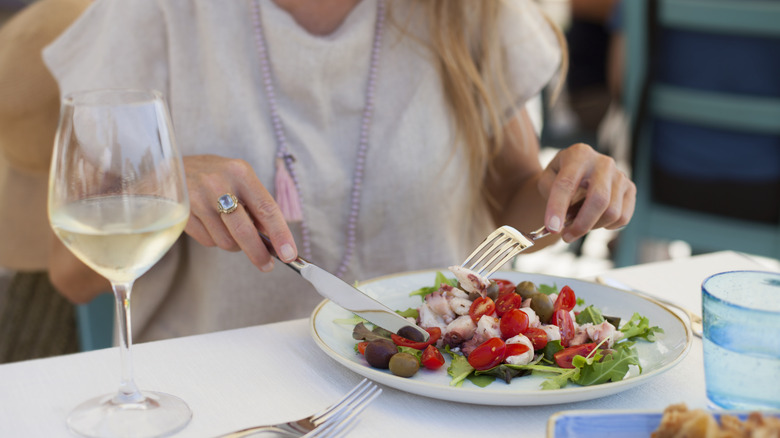An Easy-To-Digest Guide On Menus In Italy To Know Before Your Trip
In Italy, fresh ingredients aren't a luxury; they're a necessity. If something isn't in season, of high quality, or needs to be soaked in sauces to be palatable, it won't be on the menu. These elements often lead Italian fare to be simple yet all the more mouthwateringly delicious. However, just because the recipes are simple — usually using four to eight ingredients — doesn't mean the menus are.
With food being taken so seriously, the menus are elaborate, and even an everyday lunch in Italy can be several courses long. It is, after all, the most important meal of the day. But dinner can be complicated, too, starting with an appetite opener and ending with a palate cleanser.
Given that Italy has such an intricate dining culture, Explore has broken down the country's menus for you, starting with the basic protocol for breakfast and then delving into each course served at lunch and dinner. We didn't leave out the sometimes confusing aperitivi and digestivi, either. We also touched on why you should always finish your meal with a sweet shot of espresso. Here's how to eat like the Italians do — and understand the menu basics — while you're in one of the best countries in the world for food.
Breakfast
There's a reason why breakfast doesn't come to mind when thinking about the land of tomato sauce, bread, and cheese. In Italy, breakfast is short and sweet — literally. Italians often eat their breakfast while standing at a bar, which is equivalent to a café in the United States. It's so common to stand during breakfast that it often costs extra to sit down. In just about 15 minutes, Italians scarf down a coffee and a sweet pastry, a stark contrast to the thoughtful, drawn-out way they enjoy their lunches and dinners.
Usually, that coffee is a cappuccino or a caffè latte, as milk-based coffees aren't typically drunk later in the day. They're paired with sugary pastries like sweetened croissants, chocolate-filled sweets, doughnuts with powdered sugar, and Bundt cakes. Sometimes, Italians dip breakfast cookies into their coffees. In Sicily, breakfast gets even sweeter with dishes like crushed ice flavored with fruit juice and brioche filled with ice cream.
However, if you're craving savory delights for your breakfast in Italy, you're not totally out of luck, although you can forget about a massive plate of eggs, sausage, and bacon. Some bars serve foods like hot prosciutto, cheese sandwiches, and miniature tomato pies. However, that's about as cooked as it gets, as other prepared-on-the-stove items are usually not available on breakfast menus. Even if you see a sign for brunch, don't get too excited. Brunch in Italy is basically lunch, with dishes like lasagna and lamb chops on offer.
Lunch
After that quick and sugary breakfast, Italians are ready to chow down at lunch. That's part of the reason lunch is the biggest meal of the day in Italy, often lasting several hours. Italians often go home during this time and sit for several-course meals from about 12:30 p.m. to 2:30 p.m. This midday ritual includes courses like an appetizer, a first course of pasta, a second course of an entrée, side dishes, and more.
After lunch, Italy basically shuts down for a few hours as everyone, from restaurant servers to bank tellers, takes a nap during riposo. It's only natural after such a large meal, especially considering how hot some parts of Italy get during that time. Translated to "the rest," this period, similar to Spain's siesta, lasts from about noon to 3 p.m. Then, Italians go back to work before having dinner at 7 p.m. or later. This means that during the late afternoon, non-touristy areas of Italy look more like the middle of the night.
If you see a restaurant open in the late afternoon, don't take it as an invitation to stroll in and order a pizza. That's a red flag that the restaurant is a tourist trap, as Italians wouldn't eat at that time. If you get hungry during riposo, then it's better to pick up a snack at a grocery store, as some stay open during this time, or a gelateria, which operates throughout the afternoon.
Aperitivo
You're probably already hungry after seeing the delectable food on every corner in Italy. But an aperitivo, which stems from a Latin word that translates to "to open," is meant to open your appetite for the delicious meal to come. The course, usually enjoyed from about 6 p.m. to 8 p.m., often includes light, bittersweet herbal cocktails or glasses of wine paired with bites of meats, cheeses, and breads. Although aperitivi are dining musts in Italy, the tradition is believed to have originated in ancient Greece, where Hippocrates would suggest that his patients drink light cocktails to stimulate their appetites.
Italian dining is extremely regional, and aperitivi follows suit, with each location developing its own. For example, Campari is a staple of Milan, although it's now a popular aperitivo around the world. A bitter liquor with grapefruit and orange flavors, it's one of the necessary ingredients of a negroni.
Another type of aperitivo you're likely already familiar with is Aperol, which has been a leading liqueur for more than a century. Made with more than two dozen spices, fruits, and herbs, it's a complex and beloved liqueur best known for its use in Aperol spritz. For a taste of the past, try Italicus Rosolio di Bergamotto, which is inspired by the classic rosolio. Rosolio is an Italian liqueur that was widely popular until the 1700s. In 2017, its reimagined version, Italicus Rosolio di Bergamotto, hit the market.
Antipasti
All those snacks and cocktails you ate and drank during aperitivo hour weren't your appetizer; antipasti is. It starts around 8 p.m. after aperitivo, marking the meal that lasts until about 10 p.m. Translating to "before food" from Latin, the antipasti course usually consists of bread, cheeses, and cured meats. However, be sure not to dip your bread in an olive oil bottle that looks like this.
Some of the popular antipasti items served in Italy include prosciutto di parma, focaccia, ciabatta, 'nduja, and burrata. Pickled vegetables like roasted sweet peppers, sun-dried tomatoes, and artichoke hearts accompany these. Usually, antipasti selections are cold, simple, and eaten with hands rather than forks and knives. They can also include dishes like Caprese salad and bruschetta. All of these items, paired together on one family-style board, create a colorful and varied meal, including everything from sweet to salty flavors, that will get your palate ready for the courses to follow.
Depending on which region of Italy you're in, you'll find differences in antipasti menus. In Southern Italy, where fresh fish is readily available, saltwater seafood dishes are popular. Meanwhile, in Northern Italy, where the weather is cooler and food is heartier, cured meats and mushrooms are common antipasti dishes.
Wine
Choosing wine in Italy might seem challenging since the country has some of the best selections in the world. However, it is not. Here, this popular drink is as accessible as it gets, and everyone drinks it. Sometimes, people even unwind with a glass right after breakfast or with lunch. Small restaurants, also known as trattorias, often make their own house wines. Despite the cheap price of house wine, it can be nothing to scoff at. These local wines are delicious, and they always reflect the terroir and culture of the local community. For as low as €5 per liter, they're sometimes served in a carafe with no label.
If you're looking for a more upscale way to try some of Italy's 500 wine varieties, you can do that, too. Enotecas are wine bars offering large wine menus with detailed descriptions. More wines are made in Italy than in any other country, so you can always find the right sip for your palate.
Just take a look at the label of an Italian wine to learn more about it. In Italy, wines are grouped into four categories: DOCG, DOC, VdT, or IGT. From the former to the latter, these labels represent how strictly a wine was made according to regional standards. Just a few of the most iconic wines to try while in Italy include Barolo, which is the priciest wine made in the country, and Asti Spumante, a sparkling wine from Piedmont.
Primi
After you've finished your aperitivo, antipasti, and glass of wine, it's time for the primi course, or what's usually the pasta course. Depending on the meal and setting, this course could also be a soup, polenta, or rice dish. The carbohydrate-based primi course usually has little protein, but it makes up for it with a full-bodied flavor. And don't worry; you can opt for primi as your main course rather than moving on to the secondi course.
The area of the country you're in will determine which primi options you can choose from, although you can get a handle on the best of the bunch by reading about Italy's must-try pasta dishes. In Tuscany, you might spot pici, a type of pasta that is a fundamentally thick spaghetti but without the egg that spaghetti is made with. It's served with savory meats or light sauces, like cacio e pepe or breadcrumbs and olive oil.
Conversely, gnocchi, a doughy pasta typically paired with seafood or meat, is often served in chillier Northern Italy as a hearty dish. If pesto is what you're craving, then there's no better place to get it than Cinque Terre, where it's normally served with trofie pasta. But don't ever eat any of these pastas with a spoon, which is a simple dining etiquette rule that tourists frequently break in Italy.
Secondi
If you have an appetite like an Italian, or pasta just doesn't hit the spot for you, then you might want to order a secondi dish afterward. These are similar to a meat-based entrée on an American menu. You might find it easier than you think to eat both a primi and secondi course since Italian meal portions are smaller than their American counterparts.
Plus, the secondi course is counterintuitively smaller than the primi course. That's partly because secondi options are gamier and richer, like veal, steak, venison, and lamb. Italians also sometimes share a secondi course, which can be stewed, roasted, baked, fried, or grilled.
Also, unlike in American cuisine, you won't see much poultry or chicken on the Italian menu. Even in the poultry section, you're more likely to see duck and pigeon rather than chicken. But if red meats aren't your thing, you can still find plenty of seafood in this Mediterranean country. Seafood secondi options you can often choose from include sea bass, squid, octopus, cod, shrimp, and eel. If you're vegetarian, you're likely to have a rough time with the secondi course, as there usually aren't many meat-free options here.
Contorni
Contorni are side dishes, but unlike their American counterparts, they're not automatically paired with an entrée, nor do they come out with it. Instead, they'll arrive after you finish your secondi course, and you can choose whatever you see fit. If you want to eat your contorni alongside your secondi and the dishes complement one another, just tell your server by saying, "Potrebbe portarmi i miei secondo e contorno insieme."
You'll choose from no-frills, vegetable-based items that have been steamed, boiled, roasted, or grilled and adorned with a touch of high-quality, extra-virgin olive oil or seasoning. These may include grilled artichokes, zucchini stuffed with mozzarella and prosciutto, fried and battered mixed vegetables, fried Italian peppers, and a farro salad. Light, green salads can also sometimes be offered as contorni options. Being so simple, these dishes are never meant to steal the spotlight from the secondi course.
Insalata
If the contorni options weren't salads, then next, you'll get an insalata course. Like contorni, these salads will be served fresh, right from the garden, and lightly dressed with olive oil and vinegar or not dressed at all. Diners can dress their own salads as they see fit with a few ingredients on the table. That means you won't have to choose from the more complicated dressings often served in the United States, such as ranch, sesame ginger, Russian, or honey mustard.
These basic salads, not overpowered by complicated dressings, help cleanse the palate, which is one of the reasons Italians eat their insalata course after their entrée. This prepares the mouth for the sweet dolce course and also cleans it of the rich flavors of the secondi course. It's also thought that the vinegar in the salad dressing assists in amplifying wine flavors. Plus, the light dressings of the salad help produce peptides in the body, which aid in the digestion process.
Dolce
"La dolce vita," an iconic Italian phrase that translates to "the sweet life," sums up the country's attitude toward enjoying all that life has to offer. But that doesn't always include dolce, the dessert course, if an Italian is already stuffed from the half-dozen courses that came before it. If you can make room for dolci, you'll likely choose from creamy sweets with touches of local, seasonal fruit.
Those include one of Italy's most well-known desserts — the cannoli. A Sicilian sweet, this fried pastry dough filled with sweet ricotta is sometimes topped with chocolate chips or other add-ons like pistachio. You'll be able to find it in this seaside town that offers sun and Sicilian delights. Another creamy favorite in Italy is panna cotta, which is best enjoyed in Piedmont, its home region where dairy is taken seriously. Or, opt for a few scoops of gelato, which is similar to ice cream but packs more of a flavor punch while remaining silkier. If hot chocolate is your dolci of choice, then learn these points that American tourists might want to know before ordering.
Caffe
Italians never shrug off a post-dinner coffee by claiming the caffeine will keep them up at night. They believe just the opposite. Italians always finish their evening meal with an espresso, which is served in a demitasse cup. They believe that the hot shot helps their bodies process the many courses they have consumed. Caffeine in espresso fuels the body's stomach acid production and digestive enzymes, helping to break down food faster.
Despite the Italian way of savoring a meal as long as possible, espresso is thrown back quickly – just as it is when they drink it in the morning while standing during breakfast. It's also served without milk, although it's sometimes sweetened with sugar. So no, you cannot convert that espresso into a post-dinner cappuccino — also for digestive reasons. It's thought that the milk in cappuccino can upset a stomach after eating so many courses, leading to late-night visits to the bathroom. Don't bother asking why milky desserts like panna cotta and tiramisu don't get the same side-eye.
Digestivo
Coffee isn't the only beverage helping Italians digest massive meals. The digestivo does the same thing, serving as the final course of an Italian meal, which also helps settle a full stomach. Like aperitivo, there are endless digestivo to choose from, although many are high in alcohol and served neat and without ice. They're also known as "ammazzacaffè," or "coffee killers," since they help admonish the effects of caffeine. Grappa, a 60% ABV digestif made from the unwanted parts of grapes during winemaking, is even served in empty espresso cups in some parts of Italy.
If you're looking for a digestivo with a little less intensity, then opt for the iconic limoncello, a crisp, cold drink made with lemon peels, alcohol, and sugar. Those looking for an even sweeter digestivo — without the bitterness of lemon peels — should order amaretto, an almond flavor-based drink. It has a dangerously sweet taste that hides its 20% to 28% alcohol content. Or, go for the classic Amari, a herby, bitter digestivo that can contain ingredients ranging from dried orange peels to sugar syrup.
